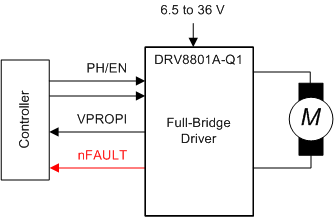SLVSC79D June 2014 – November 2020 DRV8801A-Q1
PRODUCTION DATA
- 1 Features
- 2 Applications
- 3 Description
- 4 Revision History
- 5 Pin Configuration and Functions
- 6 Specifications
-
7 Detailed Description
- 7.1 Overview
- 7.2 Functional Block Diagram
- 7.3 Feature Description
- 7.4 Device Functional Modes
- 8 Application and Implementation
- 9 Power Supply Recommendations
- 10Layout
- 11Device and Documentation Support
- 12Mechanical, Packaging, And Orderable Information
Package Options
Mechanical Data (Package|Pins)
- RMJ|16
Thermal pad, mechanical data (Package|Pins)
- RMJ|16
Orderable Information
3 Description
The DRV8801A-Q1 device provides a versatile motor-driver solution with a full H-bridge driver. The device can drive a brushed DC motor or one winding of a stepper motor, as well as other devices like solenoids. A simple PHASE and ENABLE interface allows easy interfacing to controller circuits.
The output stages use N-channel power MOSFETs configured as an H-bridge. The DRV8801A-Q1 device is capable of peak output currents up to ±2.8 A and operating voltages up to 36 V. An internal charge pump generates required gate drive voltages.
A low-power sleep mode is provided which shuts down internal circuitry to achieve very low quiescent current draw. This sleep mode can be set using a dedicated nSLEEP pin.
Internal protection functions are provided undervoltage lockout, overcurrent protection, short-to-supply protection, short-to-ground protection, overtemperature warning, and overtemperature shutdown. Overcurrent (including short-to-ground and short-to-supply) and overtemperature fault conditions are indicated via an nFAULT pin.
The DRV8801A-Q1 device is packaged in a 16-pin WQFN package with wettable flanks and exposed thermal pad (Eco-friendly: RoHS & no Sb/Br).
| PART NUMBER(1) | PACKAGE | BODY SIZE (NOM) |
|---|---|---|
| DRV8801A-Q1 | WQFN (16) | 4.00 mm × 4.00 mm |
 Simplified Application
Diagram
Simplified Application
Diagram